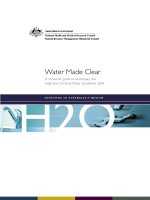A Practical Guide to Particle Counting for Drinking Water Treatment - Chapter 23 pot
Bạn đang xem bản rút gọn của tài liệu. Xem và tải ngay bản đầy đủ của tài liệu tại đây (81.75 KB, 3 trang )
201
CHAPTER
23
Particle Counting from a Market
Perspective
After evaluating all the available systems and approaches to particle counting,
it should be apparent that the “perfect” system does not exist, and never will. There
is never any way to be sure that one will make the “right” choice, as experience is
the best teacher, but experience is only acquired well after the initial selection.
It is helpful to examine the manufacturer’s perspective when evaluating particle
counter systems. Certainly there are any number of reasons behind the various ways
each company approaches the market, which would be impossible to even attempt
to explain. However, human nature and the laws of economics being what they are,
a few broad generalizations are possible. It is helpful to understand some of the
dynamics involved in the current business climate, especially for those who have
spent careers in the public sector, and have not worked in private business.
The municipal market is quite unlike the industrial markets in which most of
the particle counting companies have been involved. The long, drawn-out compet-
itive bid process is much slower and more tedious than most industrial contracts.
While all human endeavors involve some degree of politics, municipal contracts
involve politics with a capital “P,” that is, on the governmental level. Decisions are
often made with no regard for technical merit by bureaucrats who are only concerned
with costs and budgets. New plants can take several years to complete from the time
of initial specification, and the manufacturers must invest time and resources in these
projects over several years, often to receive no return. Industrial projects are usually
accomplished in a much shorter time span, with less political involvement, and the
plant personnel are generally more technically adept. The highly competitive nature
of private business places a premium on problem solving and process improvement,
and once the importance of a particular technology is ascertained, it does not take
long to implement.
As municipalities are noncompetitive, there is less urgency to improve. Water
quality is quite good in most places, and while lowering the cost of production a
few percent would benefit the taxpayer or consumer, it is not a pressing concern.
There is no great monetary incentive for investing in a particle counting system.
L1306/frame/pt03 Page 201 Friday, June 23, 2000 2:16 PM
© 2001 by CRC Press LLC
202 A PRACTICAL GUIDE TO PARTICLE COUNTING
Market forces are still the driving factor behind the advances in particle counting
technology, as in most technological development. Hiac Royco produced a complex
and expensive particle counter in the early going, while Met One developed a simpler
and lower-cost unit to compete with it in the hydraulics market. This cheaper, simpler
approach had limited appeal in the hydraulics market, but was ideally suited for the
less-sophisticated and more-price-driven municipal market. As Met One built up a
substantial share of the drinking water market against the more expensive Hiac
Royco product line, it had little incentive to improve its equipment. This allowed
PMS and Chemtrac an opening into the market with systems designed to address
some of the shortcomings of the existing equipment. It also allowed Hach to recover
from its initial entry with Hiac Royco equipment and try an improved attempt with
help from PMS. This has in turn forced Met One to improve its offering, and basically
forced Hiac Royco and PMS out of direct involvement in the water treatment market.
They have strongholds in other markets, but cannot compete at the price levels that
have resulted from this competitive situation.
The importance of competition in this area cannot be overstated. From the early
1990s Met One has been ideally situated in terms of staff and resources to lead the
way in developing particle counting technology for the drinking water industry, but
has only done so when forced by competitive realities. Chemtrac introduced several
innovations, developed by a team of experienced engineers who had been formerly
with Met One. Some were hired on a contract basis, and others left after the product
was completed, so that none of the development team is still in place. As a result,
little change can be expected from Chemtrac in the future.
It would appear that future leadership of the particle counting market will be
decided between Met One/Hach and Art Instruments/US Filter. Both have the market
presence and technical expertise necessary. Chemtrac is a smaller firm that can
comfortably exist on a smaller market share while keeping the bigger firms in line
on pricing. IBR will continue to sell to the old Hiac Royco customer base, but is
not likely to pose a bigger threat to the others.
But, as the economic skeptics like to say, in the long run, we will all be dead.
That and taxes are what we can be assured of. There is no way to know what the
future holds for particle counting in drinking water treatment. Enough questions and
problems still exist to allow for the possibility of a truly innovative entry that could
revolutionize the industry. Unless, of course, firm regulations are established, which
will likely end any new innovation in the industry. Competitive markets are what
drive innovation, as should be obvious from observing the growth in that most
unregulated of markets, the computer industry.
Regulations provide the security of a fixed standard of measure. Once in place,
the goal becomes to meet them with the smallest amount of cost, whether in terms
of price or effort. People are motivated by incentives, and will follow the path of
least resistance to achieve them. When the incentive path is changed from continual
improvement to maintenance of a fixed standard, a whole new set of attitudes will
be formed. The more positive and dynamic outlook produced by a climate of
innovation and improvement becomes a negative and static one of trying not to fail
to meet the fixed standard. Failure is punished more than success is rewarded, so
the incentive comes to be the avoidance of failure, or even the appearance of failure,
L1306/frame/pt03 Page 202 Friday, June 23, 2000 2:16 PM
© 2001 by CRC Press LLC
PARTICLE COUNTING FROM A MARKET PERSPECTIVE 203
more than striving for success. This attitude is prevalent in the water treatment
industry, because of the predominance of regulations. It explains much of the hes-
itancy about selecting a particle counting system, because no one wants to make a
“bad” choice. It is safer to defend a choice because the neighboring plants have the
same equipment, or the company has been around longer, than to defend it by virtue
of its innovative features and performance.
This attitude has become widely prevalent in private business as well, in large
part due to the abundance of regulation in all spheres of life. Fear of failure super-
sedes reward for success, and little incentive is given for those willing to risk failure.
Human nature has always been such that outside people, be they competitors or
consultants, are always trusted more than one’s own employees, no matter how well
they have performed in the past. That “prophet is never accepted in his own town”
is a well known and established truth. This goes a long way toward explaining why
outside competition drives improvement. It is never a safe bet to assume the biggest
will always be the best, and it will usually be the newest entry into the market that
will push the older established firms to improve. Little consideration is given to
customer requests for changes to products until the pinch is felt in the pocketbook.
L1306/frame/pt03 Page 203 Friday, June 23, 2000 2:16 PM
© 2001 by CRC Press LLC







![the game audio tutorial [electronic resource] a practical guide to sound and music for interactive games](https://media.store123doc.com/images/document/14/y/oo/medium_oon1401475551.jpg)

